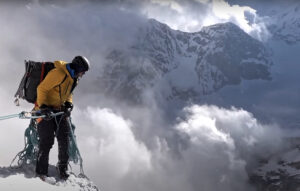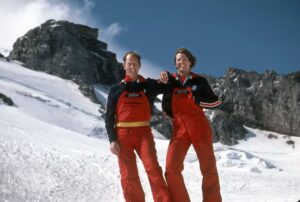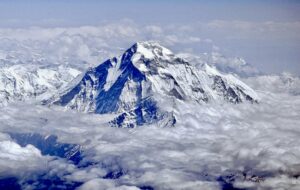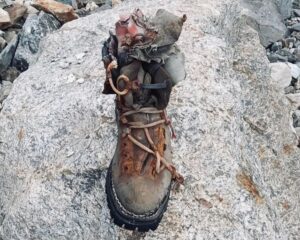The Rupal Face of Nanga Parbat is the most ambitious expedition this winter, but we have heard little about it so far. The international team members only confirmed the climb after reaching Islamabad.
They are Herve Barmasse of Italy, David Gottler of Germany and Mike Arnold of the U.S. Seasoned local climber Kudrat Ali will accompany them as liaison officer and Base Camp manager.
Climbing light, fast, and green
The goal is to climb the peak from the south, up the 4,500m Rupal Face, one of the biggest mountain walls in the world. This would be a winter first, and they are attempting it alpine style. For Barmasse, that means “zero waste left in the mountains, no pre-set camps, no help from outside, no oxygen or fixed ropes.” Instead, the men will carry 15kg backpacks and a 60m rope to belay one another.

Herve Barmasse on the lower sections of Nanga’s Rupal Face. Photo: Herve Barmasse
They hoped to be acclimatized and ready for a single summit push from BC to the top by the second week of January. “The perfect plan is two nights up and one down, in the worst case, three and two,” says Barmasse. But bad weather is delaying their acclimatization timetable.
Barmasse expects that the biggest difficulties will wait on the upper side of the route, between 7,200 and 8,200m. There, technical difficulties will add to the altitude. That part of the face also remains in the shade all day. Meaning: frigid.
“The way we want to do things is more important than the summit we want to reach,” Barmasse said. The only reservation that purists may have of their alpine-style approach is that they are acclimatizing on the same line that they intend to climb: the Schell route.
Working round the weather
So far, they have done a first rotation up that route in the only window between spells of bad weather, on December 29 and 30. From Base Camp (3,500m), they climbed up to 4,500m for the night and up to 5,670m on the following day.
“Conditions were not good,” said Barmasse. “Powdery snow and high avalanche risk.”
Bad weather forecasts discouraged the climbers from progressing further. Instead, they retreated and spent a second night at a safer bivy location at 5,000m before returning to BC in time for New Year’s Eve.

David Gottler during the first acclimatization rotation. Photo. Herve Barmasse
“We ‘only’ got to 5,600m, but on Nanga Parbat, that is over 2,000 vertical metres above Base Camp,” David Gottler pointed out. “On almost every other 8,000m peak, that vertical gain above BC puts you above 7,000m. But here, BC is low, and the summit is a long way up.”
The Schell route is the longest ever climbed on Nanga Parbat, but the team points out that despite its difficulty, it may be safer than others in winter. The key is going light and fast.
Gottler knows this well because he tried this same line in winter 2013-14, with Simone Moro, Emilio Previtali and the Polish foursome of Tomek Mackiewicz, Pawel Dunaj, Jacek Teler, and Michal Obrycki.
“It’s a bit like seeing an old friend after many years,” Gottler said. “The terrain has changed here and there, the conditions are different, being here with Barmasse and Arnold is different, and of course, I am different.”






